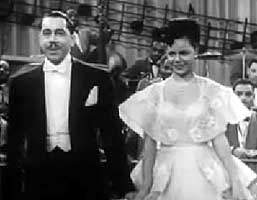 Cab Calloway & His Orchestra are the heart of Hi De Ho (1947), a little crime film designed to show off Cab's musical talents. Cab's singing & dancing are the very epitome of cool, making up for the fact that the story is minimal & the acting uneven.
Cab Calloway & His Orchestra are the heart of Hi De Ho (1947), a little crime film designed to show off Cab's musical talents. Cab's singing & dancing are the very epitome of cool, making up for the fact that the story is minimal & the acting uneven.
Minnie (Jeni Le Gon) is jealous of Cab's manger Netti (Ida James). Netti has been completely professional as a manager & not even flirted with Cab, but Minnie insists things are otherwise.
"Can't you see she's a moocher?" says Minnie. Cab says, "You're the moocher. You're Minnie the moocher," which sounds like an opening to sing one of his greatest songs, but surprisingly enough, he never sings it, though he does sing a sequel of sorts.
"Minnie's a Hep Cat Now" acapella. After a scat beginning, it toes: "Minnie's a hep-cat now/ She's as sharp as the cats allow/ Say, she's really up todate/ When she topped out in her drape/ Minnie's a hep cat now."
"Woe theire ain't no more Smokey Joe/ She's fluffed off his hi-de-ho/ She's a solid jitterbug/ And she starts to cut a rug/ Oh Minnie's a hep cat now."
Netty has gotten Cab an audition for a little club, just one step in getting him national attention. He gets together to audition to perform "Bop Bop" & a sweet, jazzy little swing tune "At Dawn Time," croonier than his usual sound:
"You grab me before I get my dinner down/ We started in poppin' all around the town/ To me it's solid labor, the jive you think is fun/ You forget about romance when the labor's done./ Dancin'. You're always dancin'. Without romancin' -- till dawn time/ Laggin'. My fight are laggin'. My heart is draggin' -- at dawn time." Plus there's a great sax solo followed by a trumpet solo with which Cab scats.
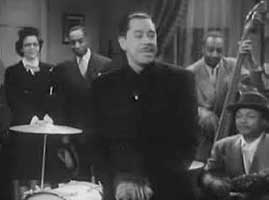 With two lines of transition Cab asks the guy he's auditioning for "Wanna hear another?" "Sure, why not," & Cab goes right into "We the Cats Shall Hep You" aka "Righteous Riff": With two lines of transition Cab asks the guy he's auditioning for "Wanna hear another?" "Sure, why not," & Cab goes right into "We the Cats Shall Hep You" aka "Righteous Riff":
"We the cats shall hep ya/ Ohhh, you reep this righteous riff, bop bop/ Now you'll hep I bet ya/ Oh, you reep this righteous riff." This is a wonderful bouncing jazz number, & it causes the club owner to say to Cab's manager Netty, "You didn't tell me he was this good!"
It's pure jump-jazz such as is usually thought of as Louis Jordan's sphere, & who's to say who influenced who the more.
Nettie meanwhile cannot believe Nettie's help is business exclusively. Angry to the core due to her imaginings about Netty, Minnie sics gangster Boss Mason (George Wiltshire) on Cab only to regret putting Cab's life in such danger. If Cab keeps drawing in the crowds at the Jive Club, & refuses to work at the Brass Hat instead, Mason plans to just kill Cab.
Unaware of these doings, Cab's having a great opening night at Mason's rival's club, a couple of instrumentals providing the soundtrack of the dramatic doings, during which Cab finds out he has half an hour to decide to come perform at Mason's or risk the worst. When Mason leaves in a huff, Cab sings "Hey Now":
"I was walking downt the street feeling sad & cold/ Deep down in my pockets I didn't have no gold/ I looked up at the sky & to my surprise/ I saw a million dollar bill floating before my eyes/ I said hey now, hey now/ Hey now, hey now."
In each verse, his good luck just gets better, an ultra-upbeat & funny jump-jazz classic. Soon after, Cab's band is doing an arrangement of Duke Ellington's "Caravan."
When Cab fails to shift alliances within half an hour, Motor "Mo" the Mouse (James Dunmore) is sent to kill Cab in Mason's behalf. But Cab gets the gun away from Mo. He doesn't realize however that Mason himself is nearby.
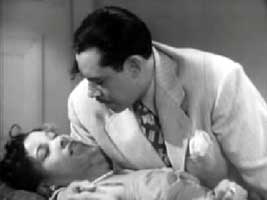 In the shoot-out Cab kills Mason, but not before Minnie gets it in the crossfire, redeeming herself by taking a bullet meant for Cab. In the shoot-out Cab kills Mason, but not before Minnie gets it in the crossfire, redeeming herself by taking a bullet meant for Cab.
As she dies in Cab's arms, he sings acapella a second time the song he wrote for her, "Minnie's a Hep Cat Now," but mournfully unlike the first time he sung it. Cab proves he really can act if it's in a song.
This is pretty much the climax of the minimal story, & the rest of the film will be music while waiting for Cab to realize he does after all love Nettie.
Meanwhile Cab goes on to great success. We see him performing to acolades around the world, when he sings the title number "The Hi De Ho Man (That's Me)" which is not the same song as "The Hi De Ho Miracle Man," both of which are sometimes just called "Hi De Ho."
He starts out with the hi-de-hos somewhat mimicking a synogogue's cantor. i saw a story that Cab did this for one of his 78 record recordings but that Jewish producers too offence & didn't release it, but I think that story is hooey. Cab's obviously doing it with affection & because he loves the sound.
Then come the lyrics which include: "How'd you like to blow your top/ Dig yourself some fine re-bop/ Hi de ho, he de he/ Oh the hi de ho man that's me."
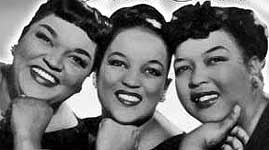 Cab's performing guests include the Peters Sisters aka Three Peters Sisters aka the Swingin' Peters Sisters aka the Terrific Peters Sisters -- Mattye, Anne & Virginia. These gals played with Duke Ellington as well as Cab. Cab's performing guests include the Peters Sisters aka Three Peters Sisters aka the Swingin' Peters Sisters aka the Terrific Peters Sisters -- Mattye, Anne & Virginia. These gals played with Duke Ellington as well as Cab.
They sing "Rainy Sunday" & "Little Old Lady from Baltimore." During the latter number Mattye Peters uses the hep cat slang "it's groovy," which rather took me by surprise as I'd thought that was a 'sixties slang. But Cab wrote the dictionary on jazz slang, literally.
Historically, the Peters sisters ended up in Europe where the American style of racism that denied them easy places to stay while on the road just didn't exist. They were big buxom ragtime & swing singers who put on a rousing good show. Mattye eventually married a Danish man & performed in Danish clubs until near the end of her life.
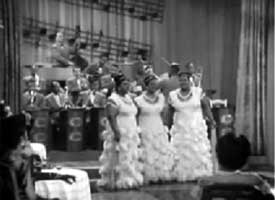 After the Peters Sisters complete their set, followed by a charus line of tapping gals, Cab comes back for a fine orchestral arrangement & spectacular vocals on his incredible classic number "St. James Infirmary Blues," inclusive of incredible dance moves. What a performance! After the Peters Sisters complete their set, followed by a charus line of tapping gals, Cab comes back for a fine orchestral arrangement & spectacular vocals on his incredible classic number "St. James Infirmary Blues," inclusive of incredible dance moves. What a performance!
The tap trio, two guys & a gal, come out to perform to an instrumental from Cab's orchestra. They're "The Miller Brothers & Lois," & the earlier group of dancers I believe were Lois Wilson with her back-up dancing gals.
Lois billed herself, like Cher, with just the one name, & though this appears to be the only film she & her brothers guested in, they were very popular in jazz clubs of the era, especially around Philadelphia.
They do a second number to a second instrumental, in which Lois & one of the brothers dance across a set of foot-stool sized letters spelling otu "Miller," practically flying through the air. During a third instrumental from Cab & the boys, a board is raised high in the air, & the tree tapdancers really take off through the sky!
Since the death of Minnie we haven't had any story at all, but it's hard to complain considering what we've gotten. But the story begins to seep back in when Cab admits he's falling in love, & sings the adoring "I Got a Gal Named Netty."
This is followed the whimsical jump-jazz number "Don't Falter at the Alter" sung to Cab by his band, while getting married on stage.
Netty & Cab have the knot tied by a rapping preacher (Bronx jazzman Augustus Smith aka Gus Smith). I hope modern rappers know jazzmen were doing that a long time ago, as it's important history. The rap is a lead-in for "Don't Falter at the Altar" written by Cab, Ida James, & Augustus Smith together.
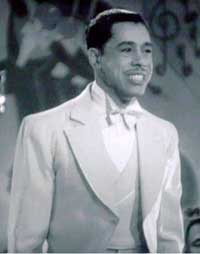 Cab Calloway in his white suit prepares us for the forthcoming set sampling the song "Jitterbug" sung like dirge, "It's the call of the jitterbug! It's the call of the jitterbug!"
Cab Calloway in his white suit prepares us for the forthcoming set sampling the song "Jitterbug" sung like dirge, "It's the call of the jitterbug! It's the call of the jitterbug!"
The stage for Jitterbug Party (1935) is the Cotton Club where Cab headlined for years. A white radio announcer set up in the audience speaks into a microphone about "the prince of hi-de-ho."
Soon we're treated to Cab dancing & shaking his hair while conducting his orchestra, then bursting into a jumpin' rendition of "Hotcha Razz-Ma-Tazz."
What a pure joy it is to watch this man perform! But he's a lot more than just head-bobbing hot jazz dynamite. He's just as marvelous with a sweetly sentimental ode to joyful Harlem nights, closing the short set with "Long 'bout Midnight."
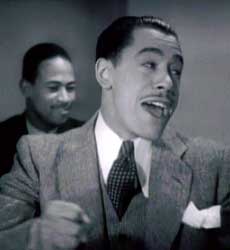 The Cotton Club performance is finished, but those Harlem nights are only just about to begin. The Cotton Club performance is finished, but those Harlem nights are only just about to begin.
Unstated in this thrilling little film is the fact that the Cotton Club catered to white folks.
The insane injustice of the times was that white folks would pay good money to be served or entertained by black folks, but would not sit at tables drinking or eating meals in the same room with black folks.
So when Cab's out of his white suit & into something just as dapper but a lot more real, he leads his friends across Harlem to the real jitterbug party.
Along the way we catch glimpses of the streets of Harlem, lively with action all night long.
Finally at Cab's jitterbug party, he completes that teaser-song "Jitterbug" from the opening credits in a room full of dancing friends, concluding with a handsome smile just for those of us in the audience.
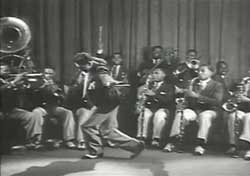 Not had enough of the great & godlike Cab Calloway? Of course you haven't! He's filmed live at the beginning of the Betty Boop cartoon Minnie the Moocher (1932), dancing in front of his orchestera. The band is playing the instrumental "Prohibition Blues." Not had enough of the great & godlike Cab Calloway? Of course you haven't! He's filmed live at the beginning of the Betty Boop cartoon Minnie the Moocher (1932), dancing in front of his orchestera. The band is playing the instrumental "Prohibition Blues."
We then cut to Betty at home with her mom & dad, who are generically ethnic, concocted from German, Jewish, Dutch & Italian.
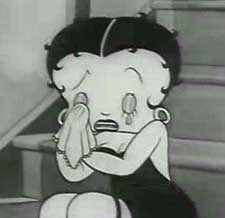 Momma & Poppa are mostly Yiddish seeming. The Fleischers were East European Jews & so probably were Betty's parents, which might explain why in later cartoons Bimbo occasionally sings Yiddish songs to Betty whenever she needs cheering up. Momma & Poppa are mostly Yiddish seeming. The Fleischers were East European Jews & so probably were Betty's parents, which might explain why in later cartoons Bimbo occasionally sings Yiddish songs to Betty whenever she needs cheering up.
Poppa is very angry at Betty, having reduced her to tears at the dinner table, apparently losing his temper merely because she eats too little, though it's not entirely clear why he's wigged out.
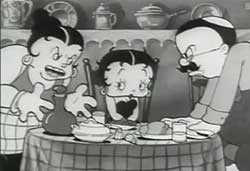 A daisy in a cup of water tries to comfort her. The daisy tries to give her a spoonful of mom's cooking (looks like mush or mashed potatoes). A daisy in a cup of water tries to comfort her. The daisy tries to give her a spoonful of mom's cooking (looks like mush or mashed potatoes).
When Betty turns it down, the flower eats it itself, loses its petals, & keals over dead. So much for home cooking!
Papa's head has turned into a Victorola spewing unintelligibly angry sounds at his poor downtrodden daughter. Betty runs off & Mama changes Papa's record to a violin rendition of "I'm a little dutch boy."
Betty sings "They'll All Be Sorry that they Picked On Me" as she writes a farewell letter before running away.
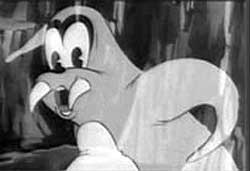 Koko the Clown appears from Betty's inkpot momentarily, a recurring gag in Fleischer Brother cartoons regarding characters drawn in black & white from an ink pot. Koko the Clown appears from Betty's inkpot momentarily, a recurring gag in Fleischer Brother cartoons regarding characters drawn in black & white from an ink pot.
Betty's dog-pal Bimbo helps her out the window & they run away together, taking shelter in a haunted cave. A ghost-walrus begins singing "Minnie the Moocher" with back up from skeletons & ghosts.
The walrus sings & dances just like Cab. Many spooky occurrences impinge on Betty, including three ghosts sent to the electric chair.
As the number closes, all the spirits, witch, devils & weird things chase Betty & Bimbo home, which she now appreciates, while "Vine Street Drag" by Cab's orchestra fills the soundtrack, the street celebrated by many Harlem jazz musicians. This cartoon provides one of the greatest of all Betty's appearances, thanks mostly to Cab.
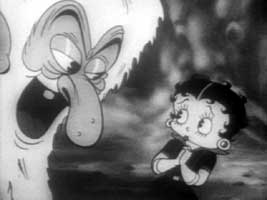 Issued just before the Production Code of 1934 which stifled Betty's sex appeal thereafter, The Old Man of the Mountain (1933) is one of the truly great Boops..
Issued just before the Production Code of 1934 which stifled Betty's sex appeal thereafter, The Old Man of the Mountain (1933) is one of the truly great Boops..
The film's spectacular character is due to the pleasantly scary animation & the title song performed by Cab Calloway, sometimes in actual duet with Betty, vocalized in these films by Mae Questrel, the best of all the Helen Kane imitators.
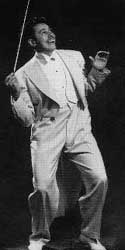 Given the racism of the era, a chance to see the real Helen Kane & Cab Calloway together wouldn't've been at all likely, but in a cartoon Cab can be a scary old white guy & hang out in the haunted cave singing with Betty. Given the racism of the era, a chance to see the real Helen Kane & Cab Calloway together wouldn't've been at all likely, but in a cartoon Cab can be a scary old white guy & hang out in the haunted cave singing with Betty.
Not that racists were slow to complain even so. Because the Fleischers promoted black music to white audiences, they received death threats from the Ku Klux Klan.
Before the cartoon stars we get to see live-action of the Hi De Ho man himself in white suit swaying in front of his orchesetra singing the opening of "The Old Man of the Mountain." Cut to some jivin' goats & a lion on rabbit-skates warning the village that the Old Man of the Mountain is near. Villagers start clearing out.
Betty is staying at Tourist House & doesn't know what's going on, so has it explained to her by a singing owl voiced by Cab. Far from being frightened by the very thought of the Old Man of the Mountain, Betty decides to go up ther & give that old man a piece of her mind. Our bold miss braves the mountain with a high-step before the spooky old man does his duet with Betty.
The Old Man does a Cab dance as a kind of precursor to Michael Jackson's moonwalk, then chases Betty out of the cave, through the moonlight, singing "The Scat Song" along the way. At one point he even rips off all her clothes, something not allowed after the Production Code took effect the next year. She hid behind a tree until her clothes ran back to her. All the local animals rush to Betty's aid & tie up the Old Man & pull his nose & tickle his feet. Wonderful!
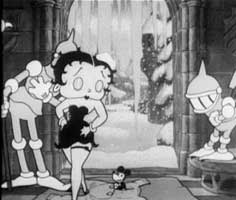 Cab Calloway is guest star again in Snow White (1933), performing "Saint James Infirmary Blues."
Cab Calloway is guest star again in Snow White (1933), performing "Saint James Infirmary Blues."
The ugly stepmother hears a bit of truth from her magic mirror & becomes the enemy of Snow White, played of course by Betty Boop. She sings a sad song "Always in the Way" while being prepared for beheading.
Koko the Clown & Bimbo the dog are guards in the queen's castle assigned to behead Betty. They completely screw it up (apparently they would've beheaded her if they were more competent), so Betty runs away, gets rolled up in a big snowball which roll into an icy pond where she's frozen in a block of ice which the seven dwarves take to Mysterious Cave.
The dwarves fetch Koko the Clown to help, apparently a second role for him, this time as a physician, for he's no longer the queen's guard. He sings "Saint James infirmery Blues" dancing like Cab.
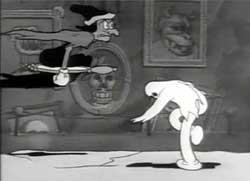 The queen disguises herself as a witch & sets out to find & destroy Betty. In Mysterious Cave the witch turns Koko into a wonderful rubbery-legged ghost which keeps dancing like Cab while singing. After the witch does her worst, the mirror turns her into a dragon & restores Betty, Koko, & Bimbo. The queen disguises herself as a witch & sets out to find & destroy Betty. In Mysterious Cave the witch turns Koko into a wonderful rubbery-legged ghost which keeps dancing like Cab while singing. After the witch does her worst, the mirror turns her into a dragon & restores Betty, Koko, & Bimbo.
Again, one of the great Betty cartoons, thanks mainly to Cab. In fact, there may well not be any Betty Boop cartoon as good as these three with Cab Calloway, & I can say that having seen nearly all of them.
Cab as the title character of The Old Man of the Mountain & the Ghost Walrus of Minnie the Moocher is not playing a black man, but some have interpretted these characters' menace toward Betty as symbolic of the cultural threat jazz was to bland white culture, & the black man to white women.
I find both those characters too playful to be real threats & jazz was Betty's life's blood, not her destruction. Even supposing the purported symbolism was there, it can't be said of Cab as Koko the Clown. Koko could well be a black man for all anyone can tell, since he's always made up as a clown, but most certainly he's no threat when he shows up as the doctor, & he has to escape the witch's evil doings same as Betty.
copyright © by Paghat the Ratgirl
|
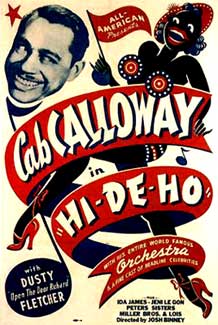

 With two lines of transition Cab asks the guy he's auditioning for "Wanna hear another?" "Sure, why not," & Cab goes right into "We the Cats Shall Hep You" aka "Righteous Riff":
With two lines of transition Cab asks the guy he's auditioning for "Wanna hear another?" "Sure, why not," & Cab goes right into "We the Cats Shall Hep You" aka "Righteous Riff": In the shoot-out Cab kills Mason, but not before Minnie gets it in the crossfire, redeeming herself by taking a bullet meant for Cab.
In the shoot-out Cab kills Mason, but not before Minnie gets it in the crossfire, redeeming herself by taking a bullet meant for Cab. Cab's performing guests include the Peters Sisters aka Three Peters Sisters aka the Swingin' Peters Sisters aka the Terrific Peters Sisters -- Mattye, Anne & Virginia. These gals played with Duke Ellington as well as Cab.
Cab's performing guests include the Peters Sisters aka Three Peters Sisters aka the Swingin' Peters Sisters aka the Terrific Peters Sisters -- Mattye, Anne & Virginia. These gals played with Duke Ellington as well as Cab. After the Peters Sisters complete their set, followed by a charus line of tapping gals, Cab comes back for a fine orchestral arrangement & spectacular vocals on his incredible classic number "St. James Infirmary Blues," inclusive of incredible dance moves. What a performance!
After the Peters Sisters complete their set, followed by a charus line of tapping gals, Cab comes back for a fine orchestral arrangement & spectacular vocals on his incredible classic number "St. James Infirmary Blues," inclusive of incredible dance moves. What a performance!
 The Cotton Club performance is finished, but those Harlem nights are only just about to begin.
The Cotton Club performance is finished, but those Harlem nights are only just about to begin.
 Momma & Poppa are mostly Yiddish seeming. The Fleischers were East European Jews & so probably were Betty's parents, which might explain why in later cartoons Bimbo occasionally sings Yiddish songs to Betty whenever she needs cheering up.
Momma & Poppa are mostly Yiddish seeming. The Fleischers were East European Jews & so probably were Betty's parents, which might explain why in later cartoons Bimbo occasionally sings Yiddish songs to Betty whenever she needs cheering up. A daisy in a cup of water tries to comfort her. The daisy tries to give her a spoonful of mom's cooking (looks like mush or mashed potatoes).
A daisy in a cup of water tries to comfort her. The daisy tries to give her a spoonful of mom's cooking (looks like mush or mashed potatoes). Koko the Clown appears from Betty's inkpot momentarily, a recurring gag in Fleischer Brother cartoons regarding characters drawn in black & white from an ink pot.
Koko the Clown appears from Betty's inkpot momentarily, a recurring gag in Fleischer Brother cartoons regarding characters drawn in black & white from an ink pot.
 Given the racism of the era, a chance to see the real Helen Kane & Cab Calloway together wouldn't've been at all likely, but in a cartoon Cab can be a scary old white guy & hang out in the haunted cave singing with Betty.
Given the racism of the era, a chance to see the real Helen Kane & Cab Calloway together wouldn't've been at all likely, but in a cartoon Cab can be a scary old white guy & hang out in the haunted cave singing with Betty.
 The queen disguises herself as a witch & sets out to find & destroy Betty. In Mysterious Cave the witch turns Koko into a wonderful rubbery-legged ghost which keeps dancing like Cab while singing. After the witch does her worst, the mirror turns her into a dragon & restores Betty, Koko, & Bimbo.
The queen disguises herself as a witch & sets out to find & destroy Betty. In Mysterious Cave the witch turns Koko into a wonderful rubbery-legged ghost which keeps dancing like Cab while singing. After the witch does her worst, the mirror turns her into a dragon & restores Betty, Koko, & Bimbo.